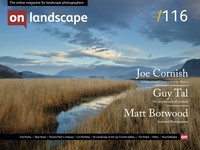Landscape and the aesthetics of restriction

Thomas Peck
The real pleasure of photography is that it forces me to slow down and really look. That’s never easy in our rushed world, so a chance to stop, look and see is truly valuable.
Photographers have to make many decisions while creating a photograph. At the most basic level, however, there are perhaps two key decisions that face every photographer. These decisions are linked and are fundamental to the success of the image. The first is how to frame up the image, and the second is how to organise the elements within the frame. What to select from the whole, and how to emphasise it? Many genres allow a certain amount of freedom within these constraints.
A studio portraitist can control light; a still life photographer can move objects. Landscape photographers have less leeway. They must necessarily deal with what is there. They are ‘caged by restrictions’ as John Fowles writes in his forward to Fay Godwin’s Land, imprisoned in a ‘tacit contract with external reality’. All of which makes it that much more difficult to stamp a personality, a character, on a series of landscape images.
Michael P Berman stamps his personality very clearly on images he makes in the border wilderness lands between America and Mexico. His focus is the local issues of the land – mining, grazing, timber, water, etc. He speaks about how he needs to wander into the land and take the time to connect with it. His photographs only come about after he has spent considerable time in a place because this changes the way he sees. At first, it is hard to get beyond the cliché superficial image. With time, and repeated visits, what is there is revealed and becomes magical. He builds a relationship over time with the land, with what he calls “the unique quality of real things”. This extended time heightens his perception of the land and only then does he start to make images.

